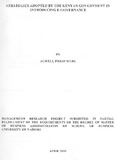| dc.description.abstract | Technology is an emerging and important trend. New information and communication technologies are both cause and effect of these changes. On the same breath, the emergence of e-Government offers potential to reshape the public sector and build relationships between citizens and the government through provisioning convenient access to government information and services, to improve the quality of services and provide better opportunities to participate in democratic institutions and processes. The e-Government movement is being driven by the need for Government to cut costs and improve efficiency, meet citizen expectations and improve citizen relationship and facilitate economic development.
Kenya has put in place strategies that include a fully functional Institutional Framework for e-Government. The implementation actions were operationalized in three phases, namely short term, medium term and long term. This was done to ensure systematic implementation of e-Government that could easily be evaluated using the target set, the achievements and the variance.
Further, the primary delivery models of e-Government can be divided into four: Government-to-Government communication; Government-to-Citizen; and Government-to-Business. In addition, the Government is undertaking to accomplish the Instituting Structure and Operational Reforms through training and awareness creation to reform and change approach to communication. The Government further aims at accomplishing regulatory and legal framework by reviewing, enacting and enforcing laws related to electronic communication and develop secure and reliable Infrastructure.
The general objective of this study was to find out the appropriateness of strategies used by government to implement e-Government. The research findings revealed that there is a relationship between various demographical characteristics and the knowledge of e-Government and ICT literacy. In order to be effective in implementation of e-Governance, the Kenyan Government has adopted different modes of reaching different classes of its citizens and other stakeholders on e-Government process. In some of these have been successful but others have not been. The study recommends the best way forward in this regard. | en |

